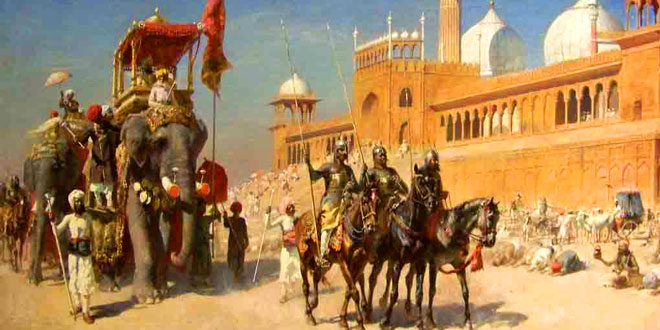Question: How did Burhan-ul-Mulk reduce Mughal influence in the Awadh region?
Answer: Burhan-ul-Mulk tried to reduce Mughal influence in the Awadh region by taking following steps:
- He first of all reduced the number of office holders (jagirdars) appointed by the Mughals.
- He also reduced the size of jagirs, and appointed his own loyal servants to vacant positions.
- The accounts of jagirdars were checked to prevent cheating and the revenues of all districts were re-assessed by officials appointed by the Nawab’s court.
Question: How did money lenders and bankers achieve influential position in the state of Awadh? Or Describe the close connection between the state of Awadh and bankers.
Answer: The state of Awadh depended on local bankers and mahcyans for loans. It sold the right to collect tax to the highest bidders. These revenue farmers known as jaradars agreed to pay the state a fixed sum of money. Local bankers guaranteed the payment of this contracted amount to the state. In turn the revenue farmers were given considerable freedom in the assessment and collection of taxes. These developments made the positions of moneylenders and bankers influential. They began to influence the management of the state’s revenue system.
Question: How did Murshid Quli Khan become powerful in Bengal?
Answer: Under Murshid Quli Khan, Bengal gradually broke away from Mughal control. He was appointed as the naib, deputy to the governor of the province. Although never a formal subadar, Murshid Quli Khan very quickly seized all the power that went with that office. Soon, he began to command the revenue administration of the state. In order to reduce Mughal influence in Bengal he transferred all Mughal jagirdars to Orissa and ordered a major re-assessment of the revenues of Bengal. Revenue was collected in cash with great strictness from all zamindars.
Question: Who were the Jats? How did they consolidate their power during the late 17th and 18th centuries?
Answer: The Jats were prosperous agriculturists. Like other states they also consolidated their power during the late 17th and 18th centuries. Under the leadership of Churaman they acquired control over territories situated to the west of the city of Delhi. By the 1680s they had begun dominating the region between the two imperial cities of Delhi and Agra. Towns like Panipat and Ballabhgarh became major trading centres in the areas dominated by them. Under Suraj Mal the kingdom of Bharatpur emerged as a strong state.
Question: The Mughal Empire had to face a variety of crises towards the closing years of the 17th century. What were the causes behind it? Or What were the causes of the fad of the Mughal Empire?
Answer: There were a number of factors that led to the decline of the Mughal Empire:
- Emperor Aurangzeb fought a long war in the Deccan. As a result, the military and financial resources of his empire got depleted.
- The successors of Aurangzeb were not at all efficient. The efficiency of the imperial administration broke down.
- It became increasingly difficult for later Mughal emperors to keep a check on their powerful Nobles appointed as governors often controlled the offices of revenue and military administration as well. This gave them extraordinary political, economic and military powers over vast regions of the Mughal Empire.
- Under the later Mughals, peasant and zamindar rebellions increased in many parts of northern and western India. These revolts were sometimes caused by the pressures of mounting taxes. The local chieftains were also becoming powerful by seizing the economic resources of the region.
- In the midst of economic and political crisis, the ruler of Iran, Nadir Shah, sacked and plundered the city of Delhi in 1739 and took away immense amounts of wealth. Again, Ahmad Shah Abdali invaded north India five times between 1748 and 1761. These invasions further weakened the Mughal Empire.
- The competitions amongst different groups of nobles also proved unfortunate for the Mughal Empire. The later Mughals were puppets in the hands of either Iranis or Turanis, the two major groups of nobles.
Question: Describe the three common features of the states like Awadh, Bengal and Hyderabad. Or What common features were shared by these three states – Awadh, Bengal and Hyderabad?
Answer: The common features shared by these states were:
- Though many of the larger states were established by erstwhile Mughal nobles they were highly suspicious of some of the administrative systems that they had inherited, in particular, the jagirdari system.
- Rather than relying upon the officers of the state, all the three regimes contracted with revenue-farmers for the collection of revenue.
- The third common feature in these three states was their emerging relationship with rich bankers and merchants. These people lent money to revenue farmers, received land as security and collected taxes from these lands through their own agents.
Question: Give an account of the Maratha expansion occurred between 1720 and 1761.
Answer: The Maratha empire expanded between 1720 and 1761. It gradually chipped away at the authority of the Mughal Empire. Malwa and Gujarat were seized from the Mughals by the 1720s. By the 1730s, the Maratha king was recognised as the overlord of the entire Deccan peninsula.
After raiding Delhi in 1737 the frontiers of Maratha domination expanded rapidly — into Rajasthan and the Punjab in the north, into Bengal and Orissa in the east, and into Karnataka and the Tamil and Telugu countries in the south. These were not formally included in the Maratha empire, but were made to pay tribute as a way of accepting Maratha sovereignty.
 Class Notes NCERT Solutions for CBSE Students
Class Notes NCERT Solutions for CBSE Students


